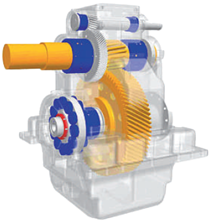Gearboxes
A gearbox uses combinations of cogwheels to provide speed and torque conversions from a rotating power source to another device. Each gearbox is characterized by gear ratio which is defined as the input speed relative to the output speed. Gear ratio can be related to one stage in the gearbox or to the whole gearbox if the latter consists of more than one stage. Overall gear ratio is a product of ratios of all stages. Also overall efficiency is a product of efficiencies of all stages.
 FIg.1. 1-stage helical gearbox. 1
FIg.1. 1-stage helical gearbox. 1
In DriveConstructor gearbox can have maximum three stages. However, in the real world some gearboxes may have more than three stages.
When choosing a gearbox the designer should remember service factors, take account of the number of starts, impact loading and the like. Typical procedure of gearbox selection includes the following steps:
- Choose gear type
- Choose transmission ratio («gear ratio»)
- Determine the nominal power rating of the gear unit
- Check for maximum torque, e.g. peak operating, starting or braking torque
- Check additional forces
- Check thermal capacity (derating due to ambient temperature)
- Check mounting (all parts to be lubricated should be lying in the oil or be splash-lubricated)
In DriveConstructor this procedure is present in a simplified version.